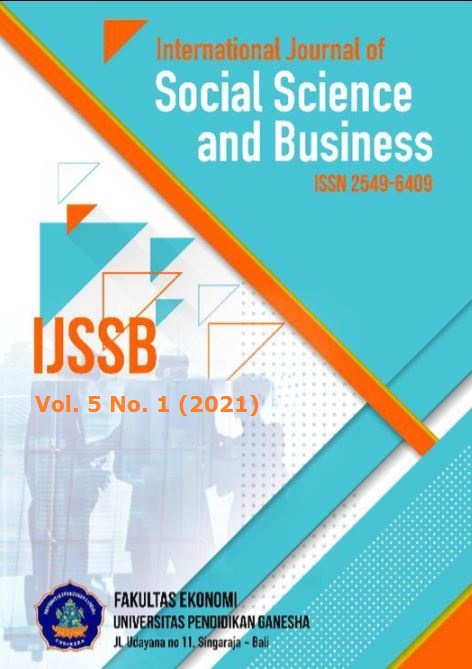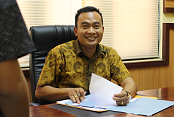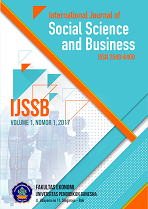Maximizing Bali Village Tourism Potential Using Penta-Helix Model
DOI:
https://doi.org/10.23887/ijssb.v5i1.30650Keywords:
Sustainable tourism, penta-helix, covid-19Abstract
The rapid growth of the tourism sector has made the government committed to implementing the principle of sustainable tourism development. To develop regional tourism, it is relatively necessary to direct, integrated, cross-sectoral, and sustainable programs so that the economic benefits of tourism are increasingly felt evenly distributed by the community. Bali, popular as one of the most tourist destinations in the world, is used as an example for the development of a national destination by the Indonesian government by creating 10 new Bali destinations, but this scheme must be postponed due to the covid-19 outbreak that hit Indonesia. This study aims to explore the sustainable tourism strategy in Bali’s village tourism sector using a qualitative approach based on content analysis based on secondary data since Bali has the largest number of village tourism in Indonesia using the Penta-helix model (synergy between academic, business, community, government, and media). With the synergy and collaboration of these five central sectors (especially during decreasing tourism sector of coronavirus outbreak), it is expected to increase awareness and maximizing the potential among the public regarding Bali sustainable tourism.
References
Amerta, I. M. S., Sara, I. M., & Bagiada, K. (2018). Sustainable tourism development. International Research Journal of Management, IT & Social Sciences, 5(2), 248–254263. https://doi.org/10.37040/geografie2001106030178
Anna Carr, Lisa Ruhanen & Michelle Whitford (2016): Indigenous Peoples and Tourism: The Challenges and Opportunities for Sustainable Tourism. Journal of Sustainable Tourism, DOI: 10.1080/09669582.2016.1206112
Aronsson, L. (2000). The Development of Sustainable Tourism. London and New York: Continuum.
ASEAN Statistics. (2020). ASEAN Visitor Arrivals Dashboard. Retrieved from https://data.aseanstats.org/dashboard/tourism
Astuti, N. N. S., Ginaya, G., & Susyarini, N. P. W. A. (2018). Designing Bali tourism model through the implementation of tri hita karana and sad kertih values. International Journal of Linguistics, Literature and Culture, 5(1), 12–23. https://doi.org/10.21744/ijllc.v5n1.461
Baiquni, M. (2002). Integrasi Ekonomi dan Ekologi dari Mimpi Menjadi Aksi. Wacana, Vol,3 (12)
Balibisnis. (2018). Jumlah Desa Wisata di Bali Meningkat. Retrieved from https://bali.bisnis.com/read/20190103/537/875046/jumlah-desa-wisata-di-bali-meningkat-signifikan
Bengtsson, Mariette. 2016. How to Plan and Perform a Qualitative Study Using Content Analysis. NursingPlus Open (2), 8-14. DOI: 10.1016/j.npls.2016.01.001
Badan Pusat Statistik. (2018). Statistik Wisatawan Mancanegara ke Bali. Retrieved from https://bali.bps.go.id/publication/2019/07/25/8c3d5ec92c9b931594a186d8/statistik-wisatawan-mancanegara-ke-bali-2018.html
Badan Pusat Statistik. (2018). Statistik Potensi Desa Provinsi Bali. Retrieved from https://bali.bps.go.id/publication/2018/12/26/2b998cd416941170b5e367a8/statistik-potensi-desa-provinsi-bali-2018.html
Badan Pusat Statistik. (2018). Statistik Wisatawan Nusantara. Retrieved from. https://www.bps.go.id/publication/2019/07/02/5249c2b645e21291b51dfc1a/statistik-wisatawan-nusantara-2018.html
Badan Pusat Statistik. (2019). Jumlah Kunjungan Wisman ke Indonesia Juni 2019. Retrieved from https://www.bps.go.id/pressrelease/2019/08/01/1615/jumlah-kunjungan-wisman-ke-indonesia-juni-2019-mencapai-1-45-juta-kunjungan-.html
Choi, G., Kim, J., Sawitri, M. Y., & Lee, S. K. (2020). Ecotourism market segmentation in Bali, Indonesia: Opportunities for implementing REDD+. Land, 9(6), 1–15. https://doi.org/10.3390/LAND9060186
Ernawati, N. M., Sudarmini, N. M., & Sukmawati, N. M. R. (2018). Impacts of Tourism in Ubud Bali Indonesia: A community-based tourism perspective. Journal of Physics: Conference Series, 953(1). https://doi.org/10.1088/1742-6596/953/1/012078
France, L. (1998). Local participation in tourism in the West Indian Islands. In Laws, E., Faulkner, B., and Moscardo, G. (Eds.), Embracing and Managing Change in Tourism (pp. 223–224). London: Routledge.
Goodwin, H., and Santilli, R. (2009). Community-based tourism: A success? Retrieved from the http://www.andamandiscoveries.com/press/press-harold-goodwin.pdf.
Hofstede, G. (2001). Culture's consequences: Comparing values, behaviors, institutions and organizations across nations. Sage publications
Honeck, D. (2008). LDC Poverty Alleviation and the Doha Development Agenda: Is Tourism being Neglected? Staff Working Paper ERSD-2008-03, World Trade Organization Economic Research and Statistics Division
Kemenpar.(2018). Laporan Akhir Kajian Dampak Sektor Pariwisata terhadap Perekonomian Indonesia. Retrieved fromwww.kemenpar.go.id/.../media_1554437393_Laporan_Akhir.pdf
Jatmiko, B. B. (2020). Perekonomian Indonesia Pasca-Pandemi Covid-19. Retrieved from Kompas website: https://money.kompas.com/read/2020/05/10/091500226/perekonomian-indonesia-pasca-pandemi-covid-19?page=all
Krippendorff, K. (2004). Content Analysis: An Introduction to Its Methodology. Thousand Oaks California: Sage Publications Inc.
Lea, J. (1988). Tourism Development in the Third World. London: Routledge.
López-Guzmán, T., Borges, O., and Castillo-Canalejo, A.M. (2011). Community-based tourism in Cape Verde- A case study. Tourism and Hospitality Management, 17(1): 35.
Nurhidayati, Sri Endah. 2007. Community Based Tourism (CBT) sebagai Pendekatan Pembangunan pariwisata Berkelanjutan. Masyarakat, Kebudayaan dan Politik. Vol 20 (3) 191-202
Piartrini, Putu S. 2018. The Relationship Among Community Based Tourism Application, Community Attitude, Community Empowerment and Community Life Satisfaction. E-Journal of Tourism. Vol. 5 (2) 130-143
Roseland, M. (2005). Towards Sustainable Communities: Resources for Citizen and Their Governments. Gabriola Island: New Society Publishers.
Sambou, O., Riniwati, H., & Fanani, Z. (2019). Socio-economic and Environmental Sustainability of Ecotourism Implementation : A Study in Ubud Monkey Forest-Bali , Indonesia. Journal of Indonesian Tourism and Development Studies, 7(3), 200–204. https://doi.org/10.21776/ub.jitode.2019.007.03.09
Scheyvens, R. (2007). Exploring The Tourism–poverty Nexus. Current Issues in Tourism, 10(2&3): 231–224.
Sebele, L.S. (2010). Community-based Tourism Ventures, Benefits and Challenges: Khama Rhino Sanctuary Trust, Central District, Botswana. Tourism Management, 31(1): 136-146. doi: 10.1016/j.tourman.2009.01.005.
Soemaryani Imas (2016). Pentahelix Model to Increase Tourist Visit to Bandung and Its Surrounding Areas Through Human Resource Development. Academy of Strategic Management Journal Vol. 15 (3)
Tasci, D.S.Asli, Semrad, Kelly J, Yilmaz, Semih S. (2013). Community Based Tourism Finding The Ezuilibrium in COMCEC Context: Setting The Pathway for the Future. Ankara:COMCEC Coordination Office
UNWTO. (2006). Tourism and Least Developed Countries: A Sustainable Opportunity to Reduce Poverty, 2006.
UNWTO. (2007a). UNWTO Development Assistance - Annual Report of the World Tourism Organization on Development Assistance Activities. Last viewed on 03/05/2013, on the http://dtxtq4w60xqpw.cloudfront.net/sites/all/files/pdf/unwtodevelopmentassistance08.pdf.
UNWTO. (2007b). ST-EP Programme- Sustainable Tourism – Eliminating Poverty: An Initiative of the World Tourism Organization (UNWTO) in conjunction with the UNWTO ST-EP Foundation. Last viewed on 03/05/2013, on the http://step.unwto.org/sites/all/files/docpdf/st-epbooklet2007.pdf.
UNWTO. (2008). UNWTO Development Assistance - Annual Report of the World Tourism Organization on Development Assistance Activities. Last viewed on 03/05/2013, on the http://dtxtq4w60xqpw.cloudfront.net/sites/all/files/pdf/unwtodevelopmentassistance08.pdf
UNWTO. (2009). Tourism Contributing to Poverty Alleviation. Last viewed on 03/05/2013. Retrieved from http://step.unwto.org/sites/all/files/docpdf/tourismcontributingtopoverty alleviation2009.pdf.
UNWTO. (2012). Tourism Highlights, 2012 Edition. Last viewed on 03/07/2013, from the http://dtxtq4w60xqpw.cloudfront.net/sites/all/files/docpdf/unwtohighlights12enhr_1.pdf.
UNWTO. (2013). Report of the World Tourism Organization to the United Nations Secretary-General in preparation for the High Level Meeting on the Mid-Term Comprehensive Global Review of the Programme of Action for the Least Developed Countries for the Decade 2001-2010. Last viewed on 03/05/2013, on the http://www.un.org/special-rep/ohrlls/ldc/MTR/WorldTourisminput.pdf
Wisnumurti, Anak Agung G.E & Rideng, I Wayan. (2017). The Development of Bali Tourism Through Cultural and Local Wisdom of Pakraman Village. Journal of Tourismologi 3 (2)
Yunas, Novy Setia. (2019). Implementasi Konsep Penta-Helix Dalam Pengembangan Potensi Desa Melalui Model Lumbung Ekonomi Desa di Provinsi Jawa Timur. Matra Pembaruan Jurnal Inovasi Kebijakan 3 (1) 37-46. DOI: 10.21787/mp.3.1.2019.37-46











